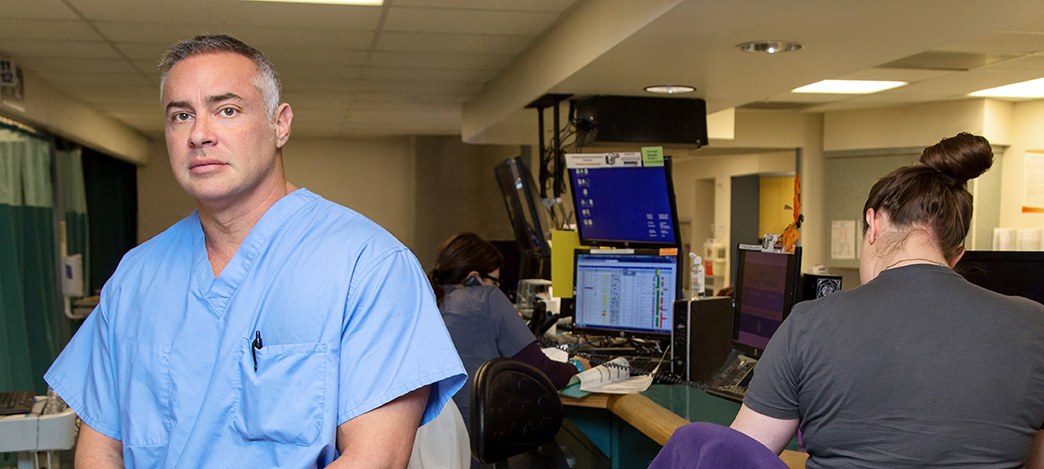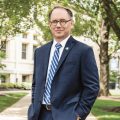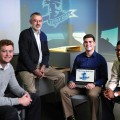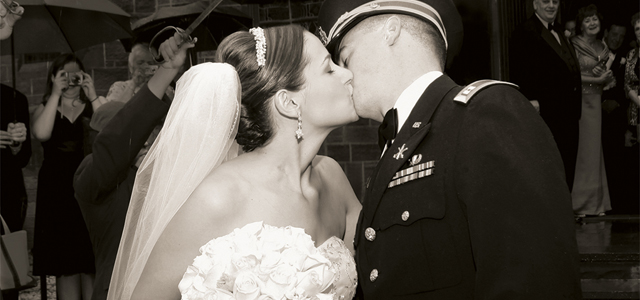Last October, when Ryan Mulvaney ’96/J.D. ’02 heard that someone had opened fire at a music festival in Las Vegas, he immediately thought of his friend Dr. Christopher Fisher ’93.
Fisher lives and works in Las Vegas, and Mulvaney could picture him and his wife, Misty, checking out that country music festival. Had they been in the crowd?
Mulvaney texted Fisher. He texted him again. He called. His friend didn’t respond to any of it. “Then I started to get nervous,” he says.
Where was Fisher? What if something had happened to him?
Fisher is one of Mulvaney’s best friends and has been since their fraternity days at Seton Hall. Mulvaney had been in Fisher’s wedding in 2016, and Fisher had a new baby at home. He had to reach him.
Finally Mulvaney got in touch with Misty, who told him that her husband had pulled on his scrubs and rushed to the hospital where he worked, and where shooting victims were arriving not only in ambulances, but by the carload.
“Once I knew he was safe and at that hospital, I felt comforted by it,” Mulvaney says. “I knew that in the midst of horror, he would make people OK — either by saving their lives or doing everything in his power to save them.”
As the medical director of trauma services at Sunrise Hospital and Medical Center in Las Vegas, Fisher is used to chaotic shifts and life-or-death decisions. But no other night in the ER could have prepared him for October 1, 2017, when he led a team of surgeons, physicians and nurses in treating more than 200 victims of the deadliest mass shooting in the country’s history.
For Fisher, the unforgettable night started around 9:30 p.m., when one of his partners at the hospital texted him about a mass casualty incident.
“We get a lot of alerts that usually end up being false alarms or a lot of minor injuries,” he says. “But I thought, I’ll just throw on my scrubs and get ready anyway. Then my pager started going off with the first gunshot wounds.”
He got to the hospital about 20 minutes after the first victims had started to arrive. “There were nurses running gurneys out to the ambulance waiting area to bring patients in, and the ER was just overflowing,”he says. “We have white floors, and those floors were pink that night because there was so much blood.”
He says that on a typical day, Sunrise Hospital may receive 20 trauma patients. That night, of the 851 people injured in the shooting, more than 200 came to Sunrise — 120 of them with gunshot wounds. (Other injuries occurred from trampling and similar run-ins during the panic.)
When Fisher got to the hospital, he headed straight to the operating room, where a patient was waiting for him on the table. He treated gunshot wounds all through the night, one surgery after another. By the next morning, he had performed five back-to-back, life-saving surgeries.
“I don’t think I started to process it until three or four days later,” he says of that night. “Everybody goes into an automatic mode and you just do what you have to do. I don’t think anybody really thought about the gravity of the situation until much later.”
For Fisher, it sank in when he returned home and saw his wife and 2-month-old daughter. “I felt so grateful,” he says, “that I was able to come home to them and that they were OK.”Like many freshmen in college, Fisher wasn’t sure what he wanted to do when he arrived at Seton Hall in 1989. “I only went into biology because I liked it and I liked the sciences,” he says.
Mulvaney was three years behind Fisher in school and a fellow member of Pi Kappa Phi fraternity. Mulvaney was also one of very few students who had a computer in his room. (At that time, only one in every four or five U.S. households owned one.)
Fisher had gravitated toward the study of biology by then and was targeting medical school. “He was not somebody you’d see at fraternity parties or the bars around town,” Mulvaney says. “More often than not, he was in my room, at my computer, working on his homework. It wasn’t that he was antisocial. It’s that even at a young age, he was focused on five years down the road.”
When his friends got into a jam, Fisher was the one who helped them. If someone got hurt during a flag football game, he took them to the medical center in East Orange.“If your car broke down, who are you gonna call?” Mulvaney says. “Chris. You’d want Chris.”
After Seton Hall, Fisher continued on to medical school at the University of Medicine and Dentistry of New Jersey. During clinical rotations, he discovered that a 12-hour day in surgery seemed to fly by when compared with a shorter, nine-hour day in medicine.
“I liked the immediacy,” he says. “If someone has appendicitis, you take out their appendix and they immediately feel better, versus giving someone medicine and it might take a week before they start getting better.”
Through his residency at Pasadena’s Huntington Memorial Hospital, he discovered a passion for traumawork in particular. He says there’s an adrenaline element to it — and as a fan of fast cars and motorcycle racing, Fisher is into adrenaline.
“The minute the trauma pager goes off and you’re waiting for the patient to come in, your heart starts pumping and your blood gets going, and it’s just very intense,” he says. “It’s funny, because when I’m away from work, I don’t want any stress. But I guess at work I kind of seek it out.”
In 2005, Fisher helped develop Sunrise Hospital into a trauma center — a designation that requires 24/7 coverage in medical subspecialties and round-the-clock surgeons, anesthesiologists and nurses who are dedicated solely to trauma work. Sheri Stucke, a nurse practitioner, joined the Sunrise trauma team a few months after Fisher arrived and they’ve worked together ever since.
“Our group is almost like a family,” she says, “and he’s the one who watches out for everybody.”
Just as Mulvaney looked up to Fisher during their time at Seton Hall and still relies on him for guidance in both his career and personal life, Stucke says other trauma surgeons at Sunrise respect Fisher and approach him for advice.
“And it’s not just our group,” she adds. “Orthopedic surgeons, neurosurgeons, cardiovascular surgeons —they all go to him if there are problems or issues because they know he will look into it and solve it.”
Stucke notes that surgeons sometimes have a reputation for being temperamental or lacking in bedside warmth, but she says Fisher is the opposite: calm, easygoing and deeply connected to the people he treats.
She says his level-headed leadership was essential the night of the Las Vegas shooting. “And at the end, when everything was over and [our team] sat down and talked about things, he made sure everybody was OK,” she says. “If anybody needed to talk, he was there for them.”
Fisher credits his Catholic faith, strengthened during his time at Seton Hall, with helping him through the night of the shooting and other difficult times. He says the strong sense of compassion that’s woven into campus life stuck with him, too.
“Your faith is something that you can really lean on to help you make sense of things and provide some comfort,” he adds. “Whether you pray to get some understanding, pray to do the best job that you can, or take comfort from your religion to get over the trauma of something like this — I think it’s helped me in all of those ways.”
Molly Petrilla is a freelance writer based in New Jersey.







